The 80s: Photographing Britain
The 80s: Photographing Britain at Tate Britain in London is a kaleidoscopic chronicle of more-or-less a decade, where photography witnessed and...
Ania Kaczynska 25 November 2024
10 November 2023 min Read
Embroidering the Earth, entrapping the moon in a cage, juggling stars—these are the elements of the fantastic and beguiling world of Remedios Varo. She stands as a female Surrealist whose recognition in the United States has been absent for over two decades. Open until the 27th of November,, a major retrospective at the Art Institute of Chicago in partnership with Mexico City’s Museo de Arte Moderno, brings us face-to-face with Varo’s mind-bending images. It reveals how the artist masterfully captured the intangible and, in doing so, became a pioneer of Surrealism in Latin America.
Remedios Varo was born María de los Remedios Alicia Rodriga Varo y Uranga in 1908 in Catalonia, Spain. Her father, a hydraulic engineer, was a freethinker who encouraged her to experiment with his drawing instruments and copy his blueprints. Her mother, a devout conservative Catholic named her after the Virgin of Los Remedios, insisted she attend a convent school. Eager to escape her reality, Varo locked herself in her room and read books by Edgar Allan Poe, Alexandre Dumas, and Jules Verne. By the age of 15, her artistic talent was undeniable and she subsequently enrolled in the Escuela de Bellas Artes in Madrid, where Pablo Picasso and Salvador Dalì had studied just years before her.
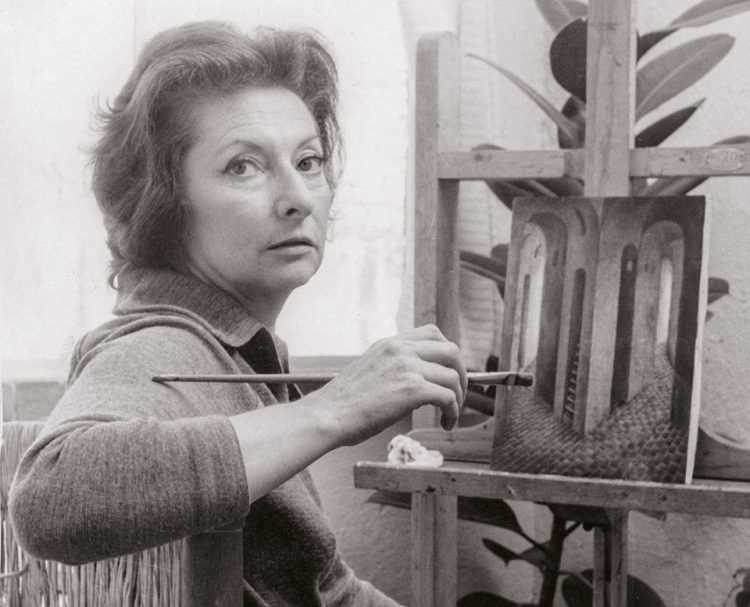
Photograph of Remedios Varo by Kati Horna, ca. 1957-58. Fundación Malba.
Varo began experimenting with the notions of the unconscious and the irrational when she joined the Spanish avant-garde group, the Logicophobistas. In 1937, Varo moved to Paris, where she pursued a bohemian lifestyle and exhibited with the Surrealists. However, with World War II looming, her destiny would soon spiral in a different direction. After being jailed in 1941 for her political activism, Varo fled war-torn Europe and never looked back. Upon her arrival in Mexico, Varo joined other European intellectual refugees and quickly created a close circle of expats, including British painter Leonora Carrington and Hungarian photojournalist Kati Horna. The three women would eventually be known as las tres brujas, or the three witches.
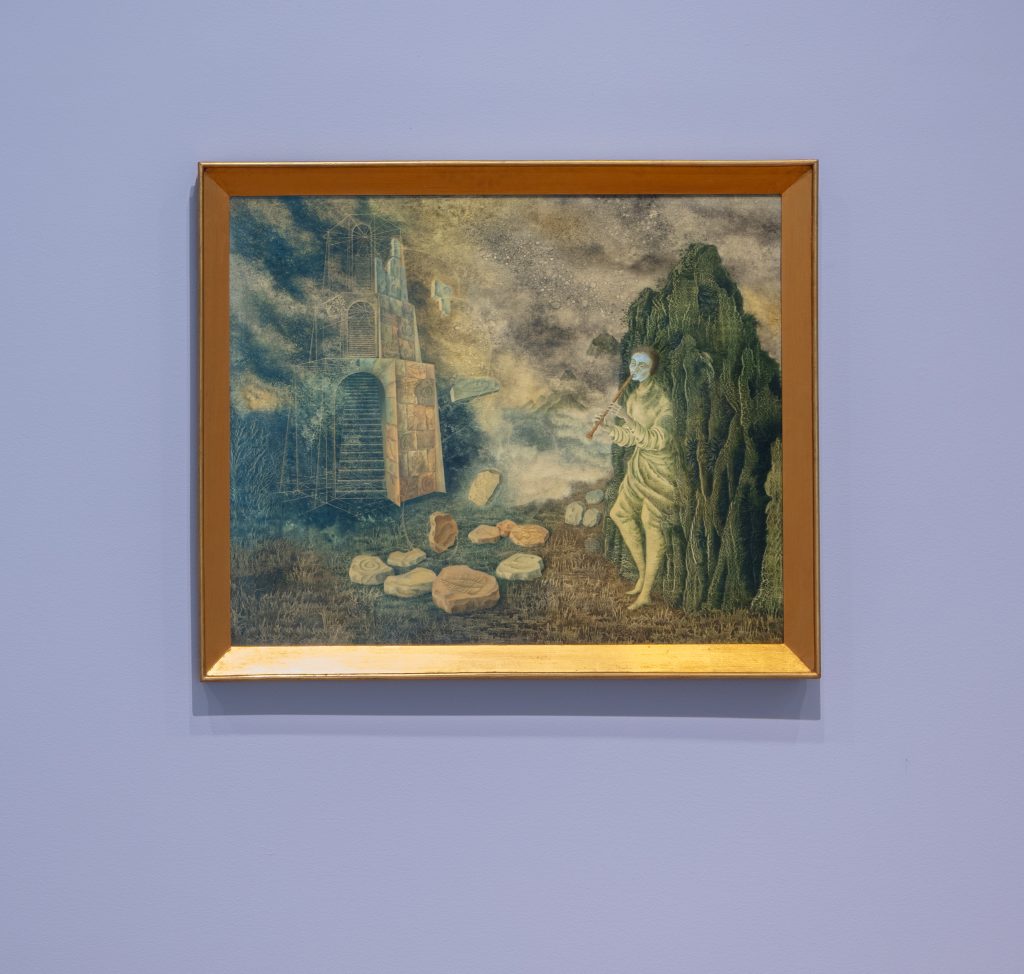
Remedios Varo: Science Fictions, exhibition view (The Flautist, 1955), 2023, Art Institute of Chicago, Chicago, IL, USA. Courtesy of the institution.
The retrospective at the Art Institute of Chicago showcases more than twenty spellbinding paintings Varo made while living in Mexico during what is known as her “prodigious decade,” from 1955 until her death in 1963.1 The exhibition space features a serpentine layout, not unlike the world we enter as we stand before her paintings. As we proceed through the perfectly paced gallery space, we encounter such masterpieces as Star Catcher (1956), Creation of the Birds (1957), and Mimesis (1960)—each its own exquisite diorama.
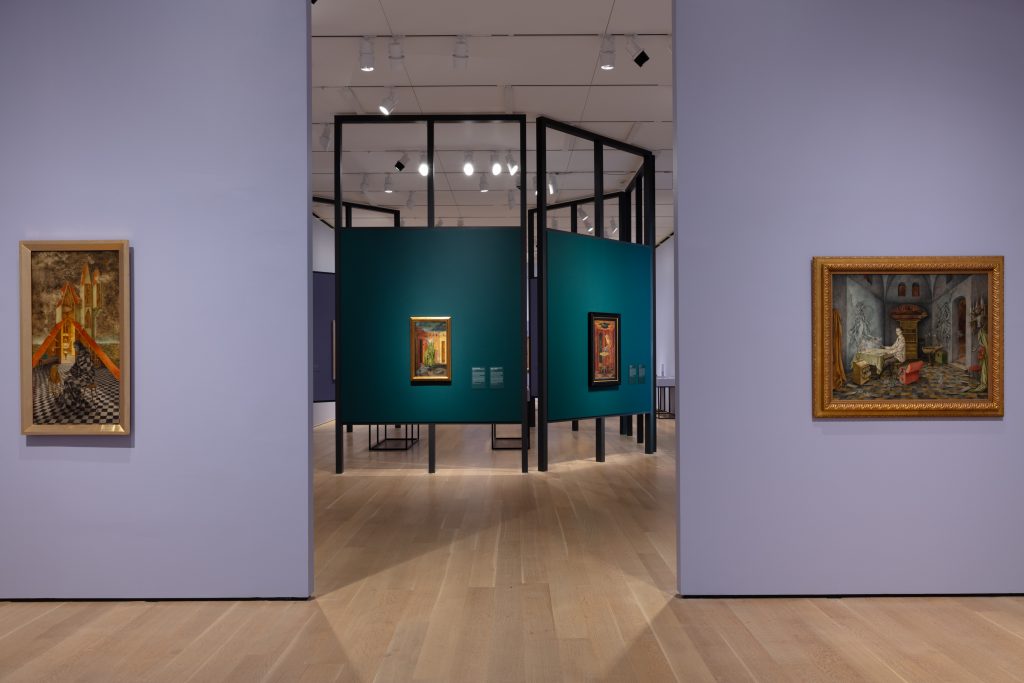
Remedios Varo: Science Fictions, exhibition view, 2023, Art Institute of Chicago, Chicago, IL, USA. Courtesy of the institution.
Featured in the center of the exhibition space are preparatory sketches, vitrines with the artist’s notebooks, paintbrushes, crystals (which Varo charged under the moon to channel energies and unlock a deepened state of awareness), and a trove of other ephemera that give us a glimpse into her creative process. With each corner turned, we dive into Varo’s exploration of the mystical and the occult. As we make our way through the gallery, we enter the rich inner worlds of solitary individuals on their quest to find truth. These wildly imaginative and gripping works—many of which are thought to be symbolic self-portraits—reveal the artist’s deep interest in tarot, astrology, and alchemy.
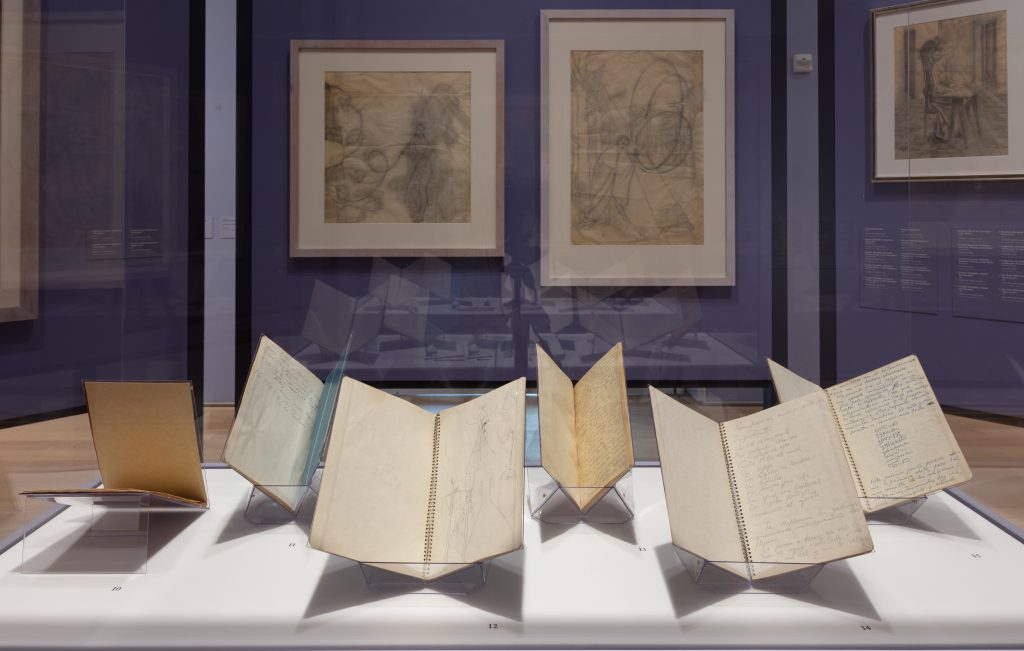
Remedios Varo: Science Fictions, exhibition view, 2023, Art Institute of Chicago, Chicago, IL, USA. Courtesy of the institution.
Varo’s scenes are delicately rendered, often exhibiting the same meticulous detail of illuminated medieval manuscripts. In her retrospective at the Art Institute of Chicago, we witness how Varo masterfully captures minutiae through various painterly techniques. These include decalcomania (Discovery, 1956); grattage (The Escape, 1961); soufflage (The Juggler [The Magician], 1956); and inlay (The Flutist, 1955), in which the artist uses inlaid mother-of-pearl for the protagonist’s face to indicate the figure’s enlightened state.
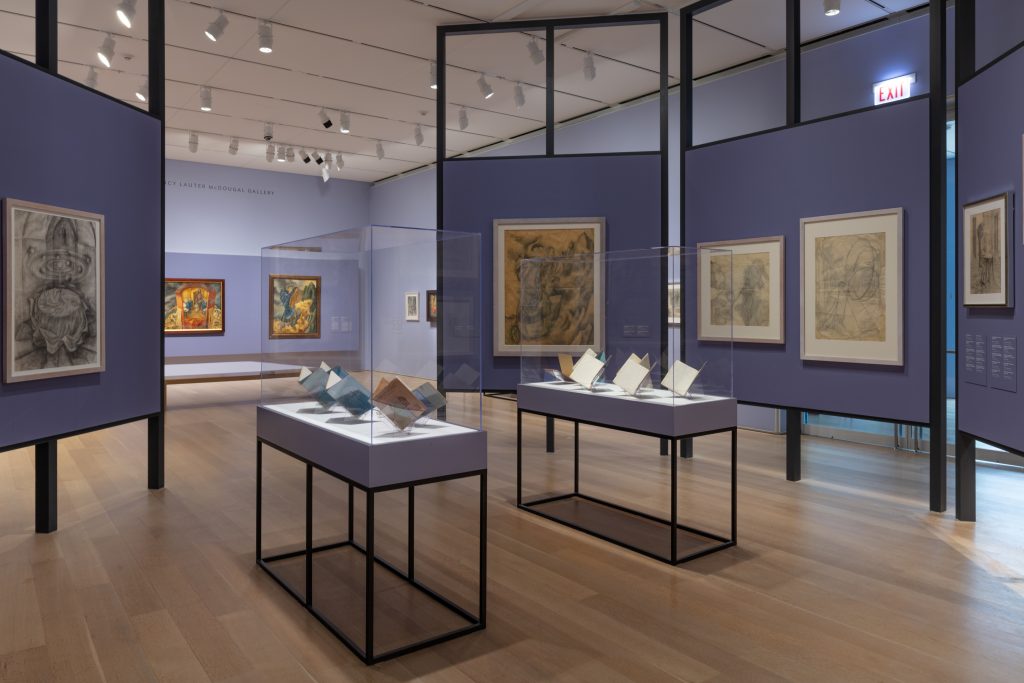
Remedios Varo: Science Fictions, exhibition view, 2023, Art Institute of Chicago, Chicago, IL, USA. Courtesy of the institution.
Our journey culminates in Varo’s stunning triptych, comprised of three richly detailed paintings. A metaphor of her early years, these works feature a group of uniformed pupils on bicycles, guided by their headmistress (Toward the Tower, 1960); seamstress girls imprisoned in a tower under the spell of their masked master (Embroidering the Earth’s Mantle, 1961); and the razor-thin protagonist, skin like porcelain, now escaping captivity with her lover (The Escape,1961). Together, these paintings create a cosmos of poetry and magic.
Remedios Varo: Science Fictions successfully brings together Varo’s later body of work, chronicling the height of the artist’s career as an émigrée. Leading up to her time in exile, she struggled to get settled—both geographically and spiritually. It wasn’t until she moved to Mexico City that Varo was able to transform tribulation into peace, tap into her imagination, and reach a heightened state of creativity, resulting in the captivating paintings we know today.
The dream world and the real world are the same.
Varo died from a heart attack at the height of her powers. She was just 54 years old. Largely unknown outside of Mexico until just recently, this female Surrealist is now securing her rightful place in history thanks to revelatory exhibitions such as this one. André Breton, the author of the Surrealist Manifesto, said it best when he described Varo as “the sorceress who left too soon.”
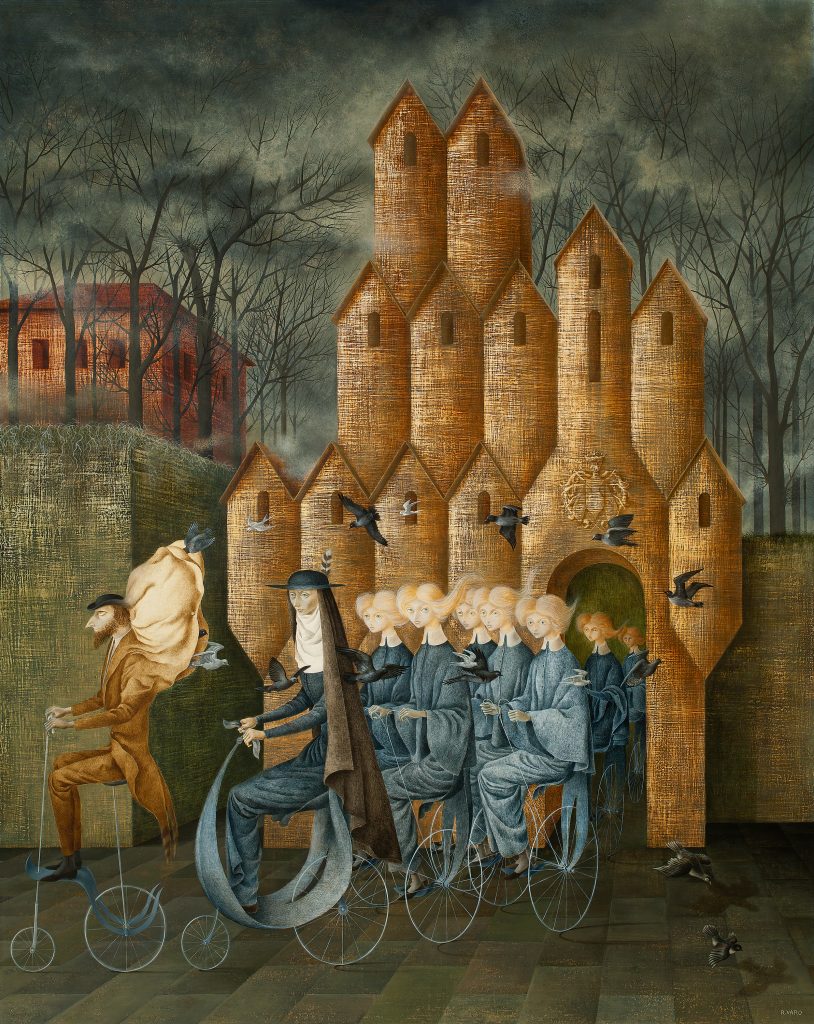
Remedios Varo. Hacia la torre (Toward the Tower), 1960. Private collection. © 2023 Remedios Varo, Artists Rights Society (ARS), New York / VEGAP, Madrid. Photograph courtesy of Sotheby’s, Inc. © 2023.
Remedios Varo: Science Fictions is on view at the Art Institute of Chicago until November 27, 2023.
To purchase tickets visit: Remedios Varo: Science Fictions | The Art Institute of Chicago (artic.edu).
Remedios Varo. Translated by Margaret Carson. Letters, Dreams, & Other Writings, Wakefield Press, 2018.
Remedios Varo. Translated by Margaret Carson. Letters, Dreams, & Other Writings, Wakefield Press, 2018.
Caitlin Haskell and Tere Arcq (edited by). Remedios Varo: Science Fictions. Yale University Press, 2023.
DailyArt Magazine needs your support. Every contribution, however big or small, is very valuable for our future. Thanks to it, we will be able to sustain and grow the Magazine. Thank you for your help!